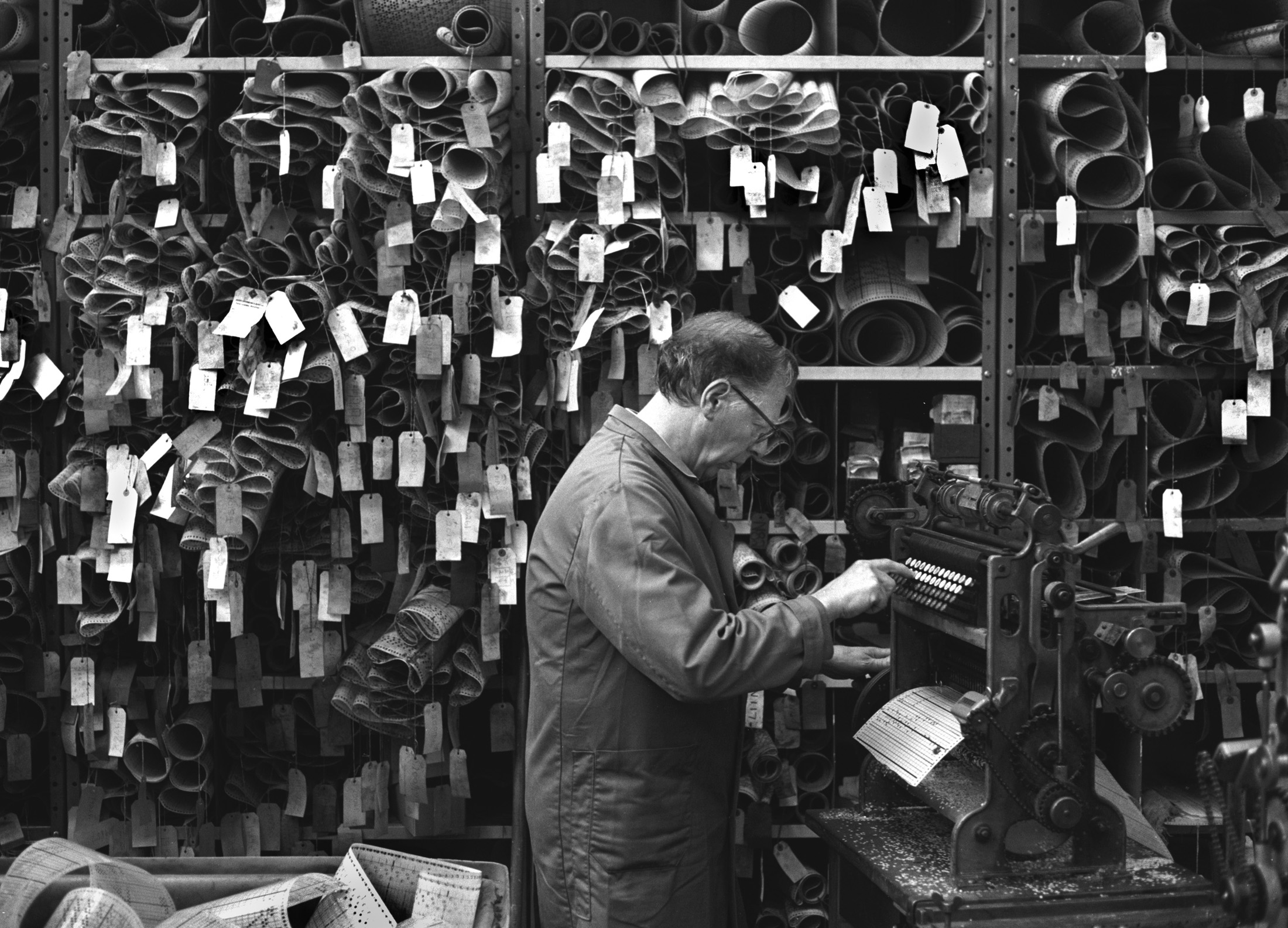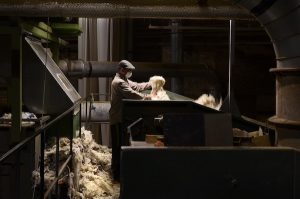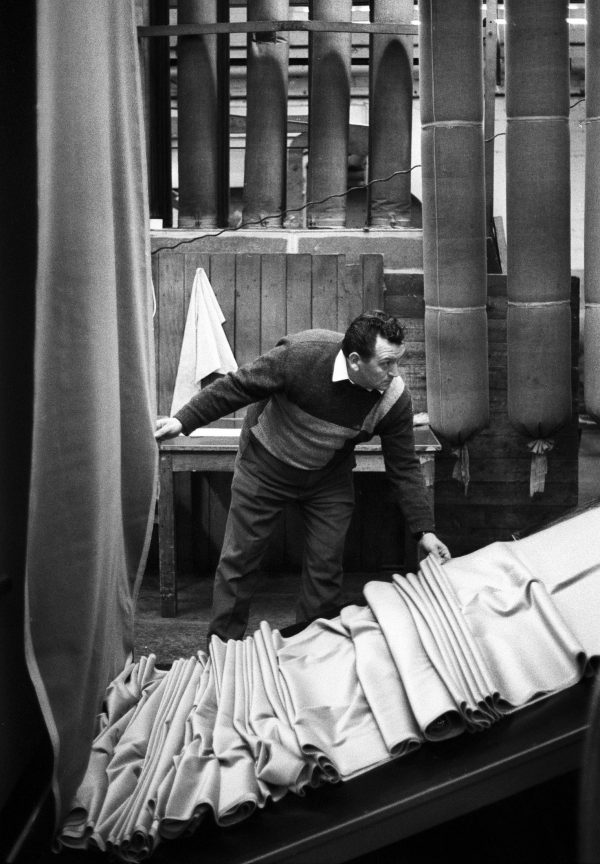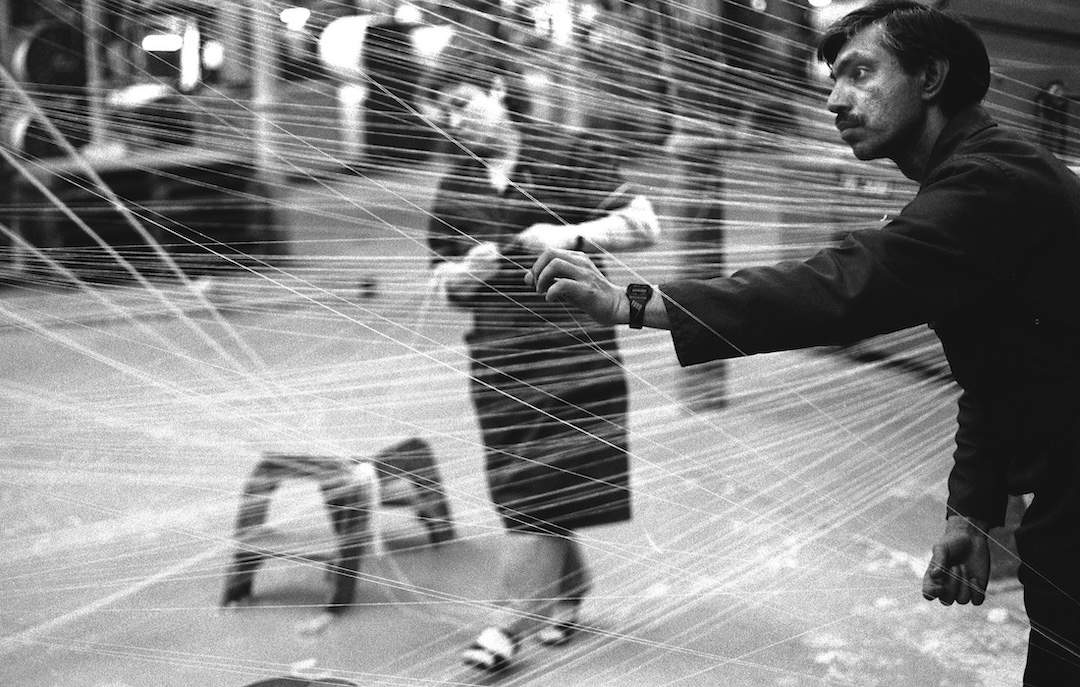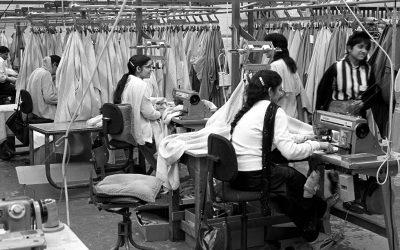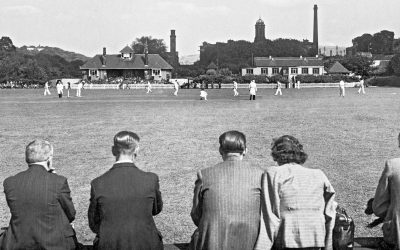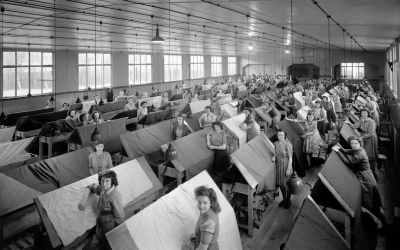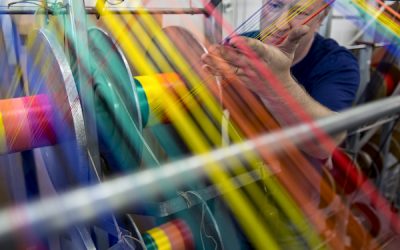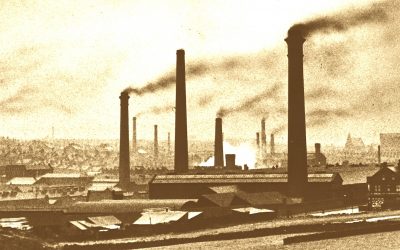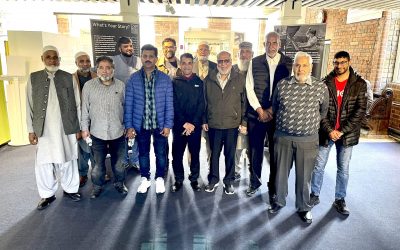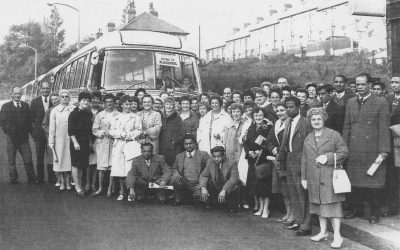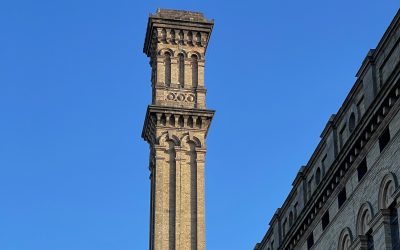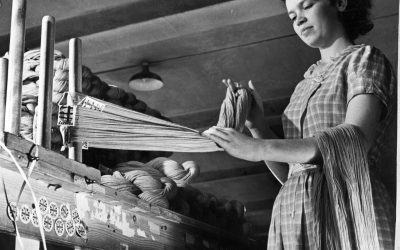If you’ve seen old mills, pictures of old mills and that, you’ll see that there’s a big mill with five or six storeys. And then at the back of it, probably, there’s a one storey part. And that’s north-facing for the light. That’s for the mending, so that they’ve got pure light. Pure north-facing light coming in so they could see properly. North-facing light doesn’t distort.
The Conditions in George Margate's Mill, Bingley, in 1976,
Susan Gee | Transcript
It was very hot in summer but very cold in winter. So I’d often have to, you know, put a couple of pairs of trousers on, the sheepskin coat. Nowhere to sit. You used to lean against the pipe or sometimes use a bobbin to sit on, you know, one of the larger bobbins to sit on. But yes, it was very dusty. It was very noisy. We didn’t have any hearing protection. We didn’t have any respiratory protection.
The process of turning the wool from a sheared sheep into a piece of fabric suitable for clothing or furniture, requires many processes, complex machinery and a very skilled workforce.
Some roles were once paid on a “piece work” rate, where wages depended on the amount of work completed. Less formally skilled workers often had to perform physically demanding, but just as necessary, labouring jobs. The working day could last anything from 6 to 8 hours, with breaks.
The descriptions below focus on woollen textiles, but all fibres (whether synthetic or natural, such as linen, cotton or animal fibres for wool) go through a process of sorting, preparation, dyeing, spinning, weaving and finishing to be made into cloth.
It was 1975, 7.00 am, and the darkness faded over the rising sun as my mum shut the door behind her. She left me and my young siblings sleeping as she walked up Wensleydale Road alongside other mill workers. My mum was never late for her 8.30 am start at Benson Turners Mill on Mount Street. The women walked down Leeds Bradford Road, passed my school towards the cobbled streets that led to the mill. My aunt had joined them from Thornbury Drive before turning off at the school junction to make her way to Whiteheads Mill. The roads along the way bustled with mill workers starting and ending shifts from various mills in the Bradford area. Most of the immigrant workers walked to work; catching a bus was a luxury. The morning chatter echoed as the women reached the tall yellow Yorkshire stone building housing Benson Turners. This was the start of a long day.
Sorting & Cleaning
Sorting
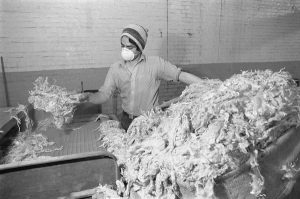
Photograph: Tim Smith | Sorting Raw Wool
The wool from the sheared fleece is sorted into different grades. A fleece will contain different fibres – some longer, finer and stronger than others. This is a highly skilled job and is still done by hand.
Scouring and Blending
Scouring cleans the wool to remove dirt and vegetation. Chemicals are used to remove the lanolin in a fleece. Lanolin is a natural oil produced by the sheep to keep their coat waterproof and can be used to make cosmetics. Scoured wool is then dried for blending to make sure it has the right kind of fibres for the finished yarn and the fabric it will be made into.
Dyeing
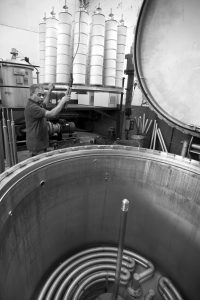
Photograph: Tim Smith | Loading a dyeing vat with yarn at Bulmer & Lumb.
The wool can be dyed after scouring or after spinning. Dyeing is a highly skilled and complex process that uses many different kinds of chemicals to produce the exact colours that have been chosen by the designers. Industrial wool dyeing is a process that involves several stages and techniques to achieve the desired colour, uniformity, and fastness of the dye.
Preparation
Carding
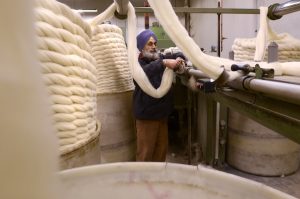
Photograph: Tim Smith | Carding at Haworth Scouring Company.
Carding uses spiked drums to disentangle the fibres, remove impurities and make the strands lie in the same direction. The end result is called a ‘sliver”. The long fibres needed for some worsted fabrics can be broken and damaged by carding so they are prepared differently.
Combing
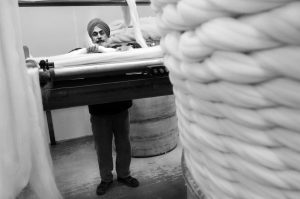
Photograph: Tim Smith | The Combing Department of Haworth Scouring Company
Combing is important for making worsted fabrics. Combing machines straighten the wool fibres and separate the short fibres from the longer ones. The longer fibres are called “tops’ and the short ones are ‘noils’.
Drawing
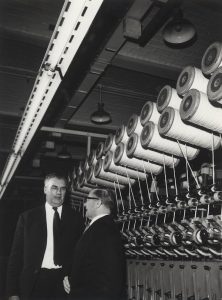
Photograph: Bradford Museums & Galleries | Drawing Machinery at Salts Mill
The combed or carded fibres go through a machine which turns a thick ‘rope’ of wool into a thinner piece called a ‘roving’. The roving can then be fed into the spinning process.
Spinning & Winding
Spinning
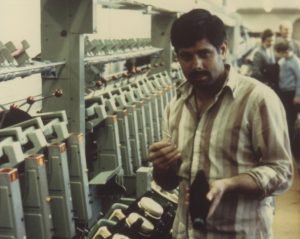
Photograph: Bradford Museums & Galleries | Spinning Worker at Salts Mill
Spinning creates a continuous thread from the roving. Spinning machines make many threads at the same time. The spinner has to quickly mend broken strands of thread. The floor of a mill would have many spinning machines operating at the same time. It was a busy and extremely noisy place to work.
Twisting
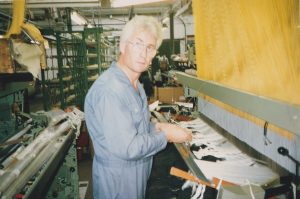
Photograph: Richard Smith | Leo Higgins, Twister at E&S Smiths
After spinning, several threads can be twisted together to add strength. Twisting makes a stronger yarn which is often used as the warp for weaving or for knitting. The warp is the long, vertical, threads on a piece of cloth. They have to be strong as they are carefully aligned and kept under tension on the loom during weaving.
Winding
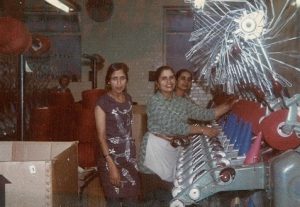
Photograph: Sabi Chahal | Sabi’s Aunt M, Mother, and Aunt G – the Winding team at Benson Turners.
Winding happens when the spun yarn or thread is transferred from its cone or spool, to something else, usually a bobbin or a larger spool. This process is crucial for preparing yarn for various textile manufacturing processes.
The men wore white coats because they were always handling the wool samples and things, which were sent off every week to be washed and starched and brought back. But we [women] were just expected to be smart. And my boss’s idea of smart was smart. And he would say, when the mini skirt came in, ‘Jean, that skirt is too short!’
The Combing Dept at Thomas Burnley & Sons Ltd
Natavar Bhai Lad | Transcript
I was put on the basic thing, like drawing the ball… They used to make the wool ball, you know, that sort of thing. So, combing department. It is semi-laboring, you can call it, because you have to work on a machine doing this. Raw wool used to come with the combs. And then the combed things, then you have to make into balls. To send it to the, you know, for the processing department. Well obviously you have to be on the ball, like. You can’t just…. that because you have to work with the machine. As machine prepare the balls you have to be ready to change the carton, you know, where the other balls can go, you know. And then you take the ball out, weigh it up, put into the bag, make sure bag is clean, there is no other debris there that… because that particular wool ball will go for further processing, where they will just take out from the bag and put it there. If there is any debris or different color things it could ruin the whole processing. Obviously that bag also get tested or checked by other department.
Designing & Weaving
Textile Design
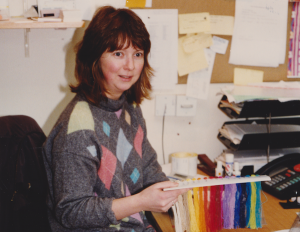
Photograph: Richard Smith | Textile Designer for E&S Smiths
Textile designers create the patterns, prints, and textures for a piece of cloth. They create many tiny ‘points’ that show where the colours need to be. They choose the colours for the pattern and select the best yarns for the cloth they want to make.
Patterns and Programs
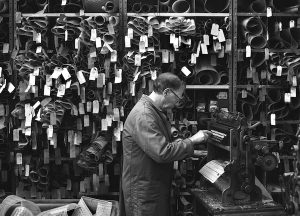
Photograph: Tim Smith | Making Pattern Cards at Drummonds Mill
When a design is finished it is made into a pattern for the weaving loom. Today this is done by computer program, but before computers a cardboard punch card system was used. Jacquard cards were used until the 1980s. The cards had holes in them that told the weaving loom how to create a perfect copy of the original design.
Weaving
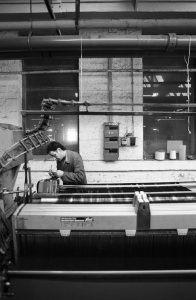
Photograph: Tim Smith | Weaving department at Drummonds Mill.
Weaving uses a loom to turn thousands of individual strands of yarn into a piece of fabric. One set of threads runs lengthways (the warp) and another set runs across (the weft). Setting up the warp threads on the ‘beam’ of the loom is highly skilled. The weft thread flies back and forth across the warp on a shuttle and the loom moves the warp strands up and down to create the final pattern. The program or Jacquard card changes how the different coloured threads are woven together to make the finished piece.
Mending, Packing & Recycling
Mending
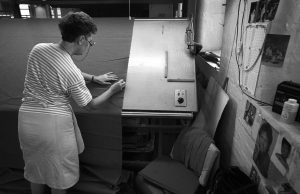
Photograph: Tim Smith | Burling and Mending Department at Drummonds Mill.
Checking or ‘perching’ the woven fabric spots any faults in the weave and they are marked up. The burler and mender then repairs any imperfections or holes in the cloth. It is then ‘finished’ which may involve flattening, dyeing, brushing, softening or making the cloth water repellent.
Packing
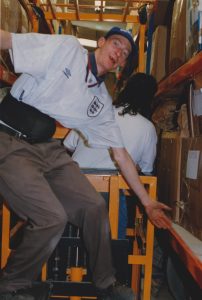
Photograph: Richard Smith | Packer at E&S Smiths
Finished fabric in textile mills is then packed to protect it from moisture, dirt, and dust. Lorries deliver the fabric to manufacturers, such as clothing companies, to be sewn into garments.
Recycling
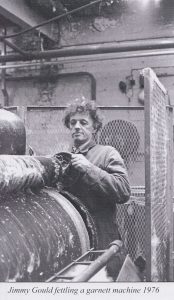
Photograph: Roger Davy | Waste Matters
Spinning and weaving produces waste wool that collects around the machines. This is collected and sent off to waste merchants (such as the Bradford Waste Pulling Company), who card and sort the waste ready for it to be spun and woven. Waste fabric is also recycled in shoddy factories that tear the woven material down to fibres which are then reused.
Behind the Scenes
Administration
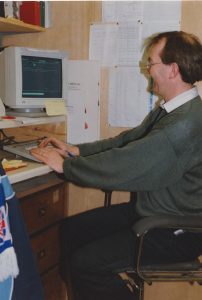
Photograph: Richard Smith | Administration Role at E&S Smiths
A working mill is like a huge machine with many different moving parts. Keeping track of everything is a big operation, with offices for finance and wages, buying and selling, planning and the creation of new designs. Sales and marketing teams travel all over the world and business managers make decisions about production and investment in ever changing economic conditions.
Laboratories
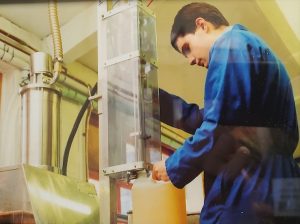
Photograph: Christeyns UK Ltd | Chemical laboratory
The science of textile production and quality control is important to ensure the finished product is up to scratch. Specialist roles in chemical and testing laboratories are very necessary. Machines have to be maintained and improved and technology kept up to date.
Logistics
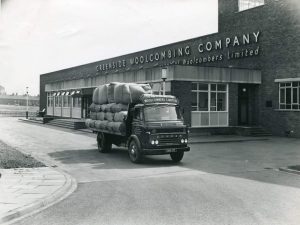
Photograph: Richard Freeman | Woolcombers’ Van
The logistics of moving, shipping, importing and exporting is a complex process. The many elements involved in textile manufacturing, from farm to the finished product requires people, preparation and constant planning. They all have to be in the right place at the right time to ensure a mill doesn’t run out of raw wool or a shipment of finished cloth doesn’t go missing.
Yarn for Tampons
Christine Davenport | Transcript
Down at Midgley’s we used to do khaki which was a really, really, very dusty wood yarn. Obviously, it’s uniforms and things. The one that we used to all dread, all those ladies dread was Gregior. It’s a form of yarn. And they actually use it for tampons. And it’s really silky white. It’s beautifully, really silky white is the rovings for these. But once they’re spun, you need a knife to cut them. You know, you couldn’t just snap them with your finger, like you could with the others. So when you’re doffing, you used to use your fingers. Pull up, use your fingers. You couldn’t do it with that. You had to use a knife.
On my first day I was fascinated with the machines. Weaving meant 100,000 threads going at the same time, people stood around, fixing the thread that broke. They were complicated and then this material came out the other end. How did someone make these machines? The workers were given a pattern to make 100 metres of this and that, they changed the thread and adjusted the machine and made cloth. Wow!

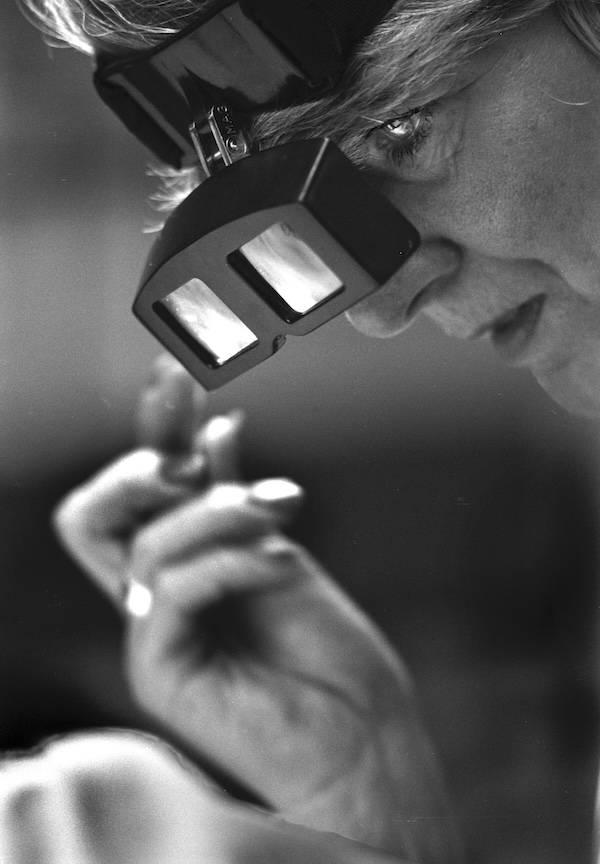
Photograph: Tim Smith | Burling and Mending Glasses at Drummonds Mill.
Father’s Ditty for Colleague Using Textile Terminology
Colin Hobson | Transcript
There was another First World War veteran worked there, an overlooker. And he’d been wounded in the upper body. He was still working, you know. When wet weather came, these wounds played up a bit, you know, in the damp. And my father wrote a ditty about him. It was…
‘Down the gate comes Charlie Quick, key in hand and picking stick, “Oh me back and oh me side, I wish to God it was Bowling Tide. I just wanted some rest.’ But a ‘gate’ is the alleyway between looms, or spinning frames, as well. ‘Picking stick’ is part of a loom. And ‘key’ is a Bradford word for a spanner. You know, a big numbspanner, and they called them keys in textile trade. You don’t see it now, but bow-legged people were called key-legged, but I think it was rickets or something. But there were lots of names.
In the beginning, I was terrified of the powerful machines. In Pakistan, we had manual sewing machines that were very slow. These machines were huge and once you put your foot down, they sped up so much I thought they would go over my hands.
Father Speaking Urdu and the Value of Burlers and Menders
Patricia Crabtree | Transcript
He [My Dad] was very proud of what he did. He was very proud of the industry that he worked in. He thought it was absolutely wonderful. He liked being amongst the mill where there were looms and everything. And he liked the people. When he was in the army, he was based in India and Burma, but he was in an Indian division. And he learnt to speak Urdu, which in those days was brilliant. So in the 1960s and ‘70s, when people started moving over to work in the mills, it was absolutely brilliant. And Dad found… he made some brilliant friends. But it was great because he could communicate. A little bit, I’m not saying he was fluent, but he knew enough to get by and be able to communicate with people. And that was good. And people always seemed to like him. He had a lot of respect for the people that worked in the mill, lots and lots of respect. He had respect for the hours that they worked and their skills. I always remember him saying things like burlers and menders, they were particularly worth their weight in gold. He said they could make or break a company, they were absolutely priceless. Just as a good weaver was.
Doffing and Winding at British Mohairs
AMS | Transcript
And I had like 600, maybe 700 bobbins to look after. Three or four sides. So if one went… doffed off – stopped, then you’d have to get it going: tie a knot, thread it through, and tie a knot and turn a handle down to keep it going. Because if you didn’t, you’d end up with different sizes. So you could take them all off and they’d be the same thickness and they’d go into a cart and they’d go elsewhere to be… something else done to them. We got paid weekly. And we got paid on how much you produced. Say, if your bobbins were stowed, you weren’t going to be making any money. So you had to get them…couldn’t say ‘I’m going for my dinner break now I’ll be back’. You had to sit there and make sure they all filled up, because it was your wage. If you didn’t do that, then you didn’t get a wage. What called piece work. They kept the machinery going constant. It were always going. It were never stood. So when I left, there was someone to take over me in the morning, you know, and he took over in the morning. And sometimes you’d go, and it were a mess. They hadn’t done what they were supposed to do, so you had to clean up and start. You know what I mean? Pick up from where they left off. So if there were some carts that were left over or half of bobbins… and sometimes… if they got stuck in the yarn, if they weren’t going onto the bobbin properly, you’d have like snags. And it’d cause problems when it went to the next job. So they’d have to get a Stanley knife and cut it off the bobbin. So if you came with a cart of bobbins for you to use, some of them still had the wool on. And you had to get a Stanley knife, cut it off so that you could use it for the next… for your job. So it was, it was constant. You were like inside of a clock. If your little cog didn’t work, the whole lot would go. You couldn’t just think, ‘Oh well, that’s just dropped, I’ll leave it two minutes.’ Because that two minutes [was] making such a difference.
I used to burl and mend. Then I left to have the children and I couldn’t go out to work, so what I used to do was take up burling and mending into the house. And I had a big cellar, with lights and that. And a table down there. And when Gerald [husband] would go onto nights, I would go downstairs and do the burling and mending. probably six hours a night. They delivered the web of cloth, they called it, to the house, maybe about 50 yards or something like that. Say there was a hole. You’d get that hole cleared by pulling out the ‘weeding shots’, what they call ‘shots’. You’d get the pattern, and you’d do the pattern. And then when you repaired it, you took it up to the lady, and she would pass it. And if it wasn’t good enough, you had to go back up and do it again
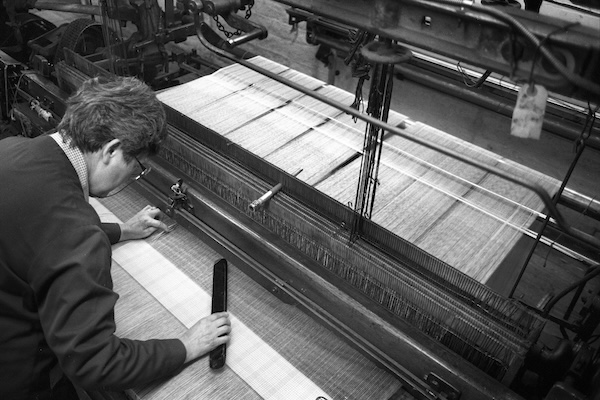
Photograph: Tim Smith | A pattern weaver, who produces the prototypes of new weaves, working on an old fashioned loom at Drummonds Mill.
Cloth for Islamic Funeral Gloves
Peter Sheperdson | Transcript
And I worked in a mill down at Bradford, right in the centre of Bradford, which was owned by the Jews, that owned that one. And I used to roll cloth for a big rolling machine like this. All this black cloth that they used to make funeral gloves with. I think they were for Muslim funerals, being made by a Jewish factory. And I used to have to roll this cloth. And that’s what I did all day. I used to go in there, roll the cloth. I learned pretty quick, because of the static on the machines, to take both my hands off at the same time. If I didn’t, I’d get a shock right from my butt and my hair would stand up! You know, from the static. It was amazing. So I did that. And I worked there for quite a while. It was a good job. I used to work there, and go to the pub, and work there, and go to the pub. That’s what I did back then. They had other types of cloth there. But the main thing was the funeral gloves. They used to send them all over the world.
Things to do...

As you can see, the process of making textiles is complex and varies depending on materials and purpose. Click on what to do next and check out the suggested activities below to take your learning to the next level:
What to do next...
Pretend you’re a textile designer, tasked with designing the next fashionable fabric! Click here to open this printout to design your cloth and decide what it could be used for (e.g. furniture, clothing, uniforms, train seats, carpets, curtains etc).
What to do next...
Using the processes above as a guide, design a poster advertising your favourite role in the mill. Make sure to include the skills needed to be good at this job and why someone would enjoy it!
Discover More
Lost Mills
Lost Mills & Ghost Mansions
Photograph: Tim Smith | UNSPUN How To Use The Learning Zone is a rich and fascinating resource for all. Take your time to explore and discover the many stories and insights on offer. Whether you are a student, a teacher, a researcher, a community group or an...
Diverse workforce
Photographs: Bradford Museums & GalleriesBackground: Bradford Museums & Galleries Photograph: Tim Smith | Combing at Haworth Scouring CompanyBackground: Bradford Museums & Galleries Photograph: Jaz Oldham | Jaz's Sister and Friend working in the mill The...
Time Off
Background: Bradford Museums & Galleries | Cricket Match in Saltaire Photograph: Jaz Oldham | Party in the MillBackground: Bradford Museums & Galleries | Cricket Match in Saltaire Photograph: Patricia Crabtree | Harold Heppleston, Patricia's Father, and...
Rights & Wrongs
Photograph: Val Rowland | Anwar Hussain (L), Bill Morris, former General Secretary of the Transport and General Workers Union (C), and Muhammad Rasab (R). Representing the racial discrimination case against John Haggas Ltd onstage at the Trade Union Annual Congress...
Changing Ways
Photographs: Mark Stevenson | Dalton Mill and Clock Tower I could see at that time that the mills were starting to close around Keighley all over the town and I thought ‘I need to be moving on somewhere’ and that's when I left in 1975 and joined the fire service....
Textiles Today
Background Photograph: Tim Smith | Laxtons' state-of-the-art spinning machinery in Baildon Title Photograph: Tim Smith | Weaving of Rainbow Ribbons at Wyedean Weaving in Haworth In 2022, I saw this job. And I rang them up and said ‘I’m looking for a job as a...
Ghost Mansions
I know that Robert Clough - he had a big mansion, and he donated a Christmas tree for the people of Keighley one year. Well, I won't be swayed on this at all. Particularly on a Friday night, when everybody else had gone home,...
Research & Map
Background Photograph: Bradford Museums & Galleries | Bradford's Skyline Title Photograph: Rainbow School | Visiting Bradford's Industrial Museum I grew up next to Marriner’s and I actually watched it burn down. It would have been in the ‘70s. I was in my...
Do It Yourself
Photograph: Alan Dix | Sangat Centre at Bradford Industrial Museum I think what people should do is show an interest in local history because one day (and I hope this never happens) there won’t be people like you, and there won’t be people like me, who...
Mediawall
Photograph: Margaret Dobson via Keighley and District Local History Society | Employees of John Haggas Ltd's Outing to Blackpool Lost Mills Media Wall Here we celebrate the rich visual history shared by contributors and project partners whilst researching Bradford's...
Archive
Photograph: Alan Dix | Lister's Mill ChimneyWelcome to the Lost Mills Archive. Here you will find all the recordings and transcripts that have been made during the lifetime of the project. It contains a wealth of information - far more than we could ever use in the...
Contributors
Thank you Lost Mills and Ghost Mansions has involved at least 500 people one way or another and their support, participation and commitment has taken us on a very special journey. Most of the people we interviewed were in their 70s and 80s and some were over 90. It is...
The contents of the 509 Arts website are protected by copyright unless otherwise stated. The Lost Mills Learning Zone recordings, text and activity suggestions are free to use for non-commercial community and education purposes. If you wish to use the materials for any other purpose, email info@509arts.co.uk with your plans.
Some of the images and video footage belong to a third party and are credited as such. If you wish to use any such content, please contact 509 Arts or the copyright owner directly.

